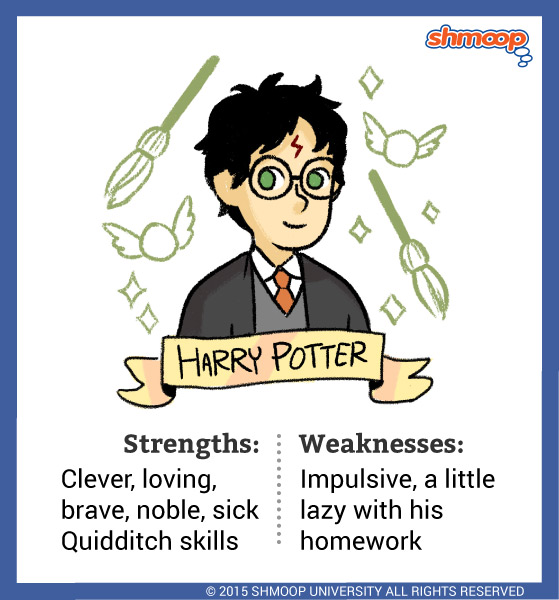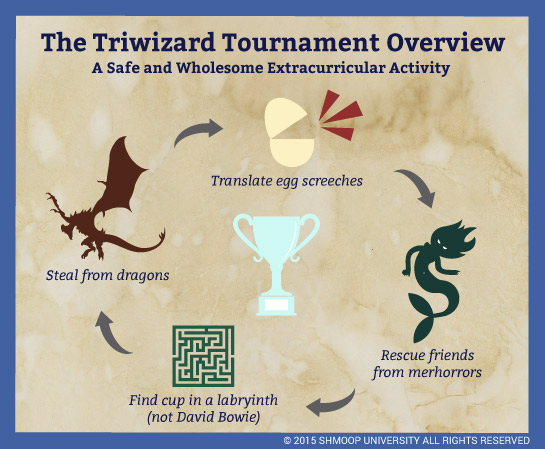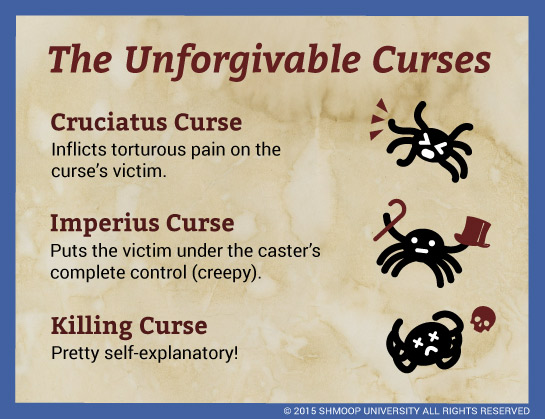Character Analysis

(Click the character infographic to download.)
House: Gryffindor, 4th Year
Triwizard Tournament: Hogwarts Champion
Ah, Harry Potter. Where do we even begin to discuss this guy's character? He's only one of the most famous fictional creations ever. What's more, we get to see totally different sides of him from Book 1 to Book 7, as he grows up in front of our eyes. In Harry Potter and the Goblet of Fire, our hero has turned fourteen years old. He's starting to discover girls (awkward), but he's still a kid in many ways. This book is a transitional one in the series, when we finally get to see the threat of Voldemort become a living, breathing (and horrifying) reality. But it's also transitional for Harry Potter's character, as he begins the clumsy process of becoming an adult.
Gryffindor Through and Through
One of Harry's defining characteristics is his courage. After all, the Sorting Hat points out that "By Gryffindor, the bravest were / Prized far beyond the rest" (12.34), and Harry is a true Gryffindor. In an interview in 2005, J.K. Rowling mentions Harry's "showy type of macho courage" (source) on the Quidditch pitch. Well, Harry shows off that "macho" courage plenty in Goblet of Fire, with his three Triwizard Tournament tasks – particularly when he faces off against a feisty Hungarian Horntail dragon with nothing but a flying broom to protect him.

(Click the infographic to download.)
Some Emotional Ups and Downs
At the same time, Harry isn't the most emotionally courageous character we've ever seen. He spends ages fretting over whom to tell about his bad dreams because he's afraid of worrying his friends and embarrassing himself. And Harry really has to work up his courage to ask Cho Chang out to the Yule Ball (with regrettable results). When he's fighting with Ron, Harry refuses to make the first move to amend things with his best friend (though we think he was right about that one). So Harry's a can-do fellow when it comes to flying into certain danger, but he's a lot less confident about expressing his feelings – like a lot of fourteen-year-olds.
But perhaps the most important discovery about Harry's character in Goblet of Fire is his natural resistance to the Imperius Curse. Mad-Eye Moody casts the curse on Harry several times during Defense Against the Dark Arts class. From the first casting, Harry fights the curse's effects. As Moody points out, "very good indeed! They'll have trouble controlling you!" (15.29). Harry's natural stubbornness may sometimes get him into trouble – as with his fight with Ron – but the good side is that he knows his own mind. And this self-awareness makes him resistant to the kind of control that Voldemort frequently tries to force on his followers.

(Click the infographic to download.)
Living Up To His Name
Harry's courage and mental toughness give him the ability to accomplish the bravest thing we see in the whole novel. At the end of the book, in the graveyard, in the middle of his wizard duel with Voldemort, Harry decides that there's "no help to be had." Even so, he will not "die crouching here like a child playing hide-and-seek; he [is] not going to die kneeling at Voldemort's feet" (34.25). He resolves to face Voldemort directly, no matter the danger. And it's this decision, to confront the Dark Lord no matter what the risk, that leads to the Priori Incantatem spell that saves Harry's life.
Harry's willingness to stand up to Voldemort demonstrates the final trait we want to underline here: his sense of fair play. Harry's OK with breaking some rules, like when he sneaks down to the kitchen with Hermione and Ron to visit the house-elves. But when it really matters, Harry believes in honor, loyalty, and all that good stuff. He tells Cedric the secret of the first task so that all champions have an even playing ground and he and Cedric agree to share the Triwizard Cup. Even though it's dangerous, Harry brings back Cedric's body to his parents because Cedric asked him to. This is why Harry gets to be the hero: not only is he usually at the center of everything bad that happens, but he also consistently represents Good (yes, with a capital "G") in the fight between good and evil.